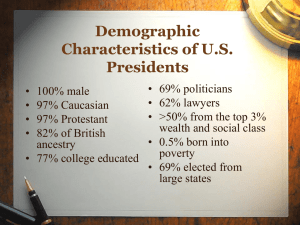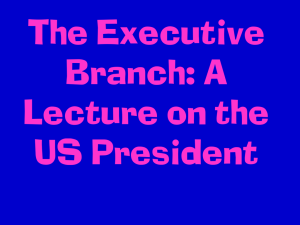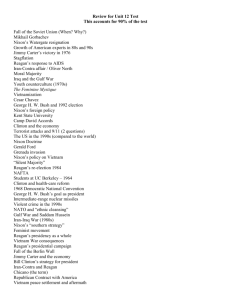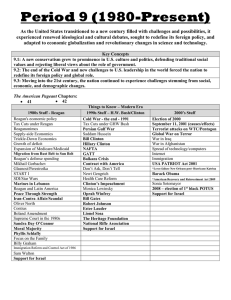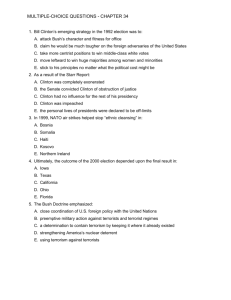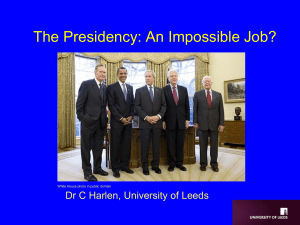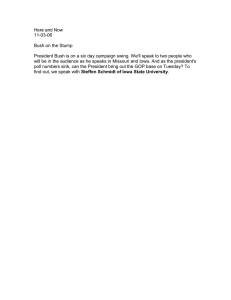U.S. Aid to Africa After the Midterm Elections? Todd Moss*
advertisement
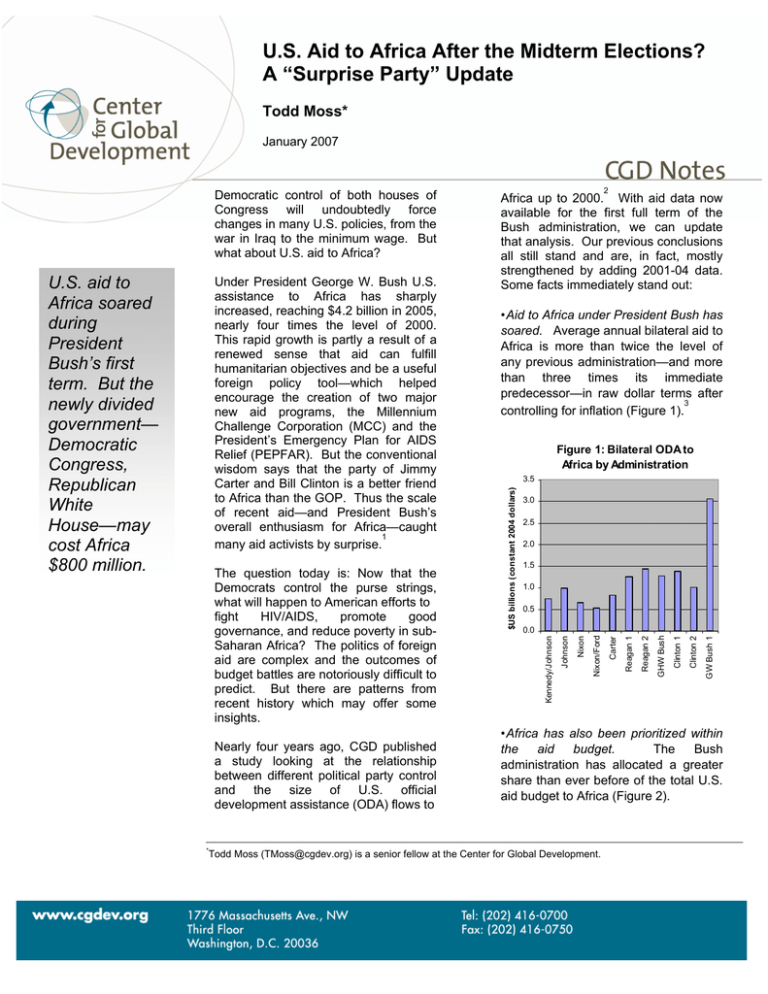
U.S. Aid to Africa After the Midterm Elections? A “Surprise Party” Update Todd Moss* January 2007 Nearly four years ago, CGD published a study looking at the relationship between different political party control and the size of U.S. official development assistance (ODA) flows to * Figure 1: Bilateral ODA to Africa by Administration 3.5 3.0 2.5 2.0 1.5 1.0 0.5 Clinton 2 GW Bush 1 Clinton 1 Reagan 2 GHW Bush Carter Reagan 1 Nixon 0.0 Nixon/Ford The question today is: Now that the Democrats control the purse strings, what will happen to American efforts to fight HIV/AIDS, promote good governance, and reduce poverty in subSaharan Africa? The politics of foreign aid are complex and the outcomes of budget battles are notoriously difficult to predict. But there are patterns from recent history which may offer some insights. •Aid to Africa under President Bush has soared. Average annual bilateral aid to Africa is more than twice the level of any previous administration—and more than three times its immediate predecessor—in raw dollar terms after 3 controlling for inflation (Figure 1). Johnson Under President George W. Bush U.S. assistance to Africa has sharply increased, reaching $4.2 billion in 2005, nearly four times the level of 2000. This rapid growth is partly a result of a renewed sense that aid can fulfill humanitarian objectives and be a useful foreign policy tool—which helped encourage the creation of two major new aid programs, the Millennium Challenge Corporation (MCC) and the President’s Emergency Plan for AIDS Relief (PEPFAR). But the conventional wisdom says that the party of Jimmy Carter and Bill Clinton is a better friend to Africa than the GOP. Thus the scale of recent aid—and President Bush’s overall enthusiasm for Africa—caught 1 many aid activists by surprise. Kennedy/Johnson U.S. aid to Africa soared during President Bush’s first term. But the newly divided government— Democratic Congress, Republican White House—may cost Africa $800 million. 2 Africa up to 2000. With aid data now available for the first full term of the Bush administration, we can update that analysis. Our previous conclusions all still stand and are, in fact, mostly strengthened by adding 2001-04 data. Some facts immediately stand out: $US billions (constant 2004 dollars) Democratic control of both houses of Congress will undoubtedly force changes in many U.S. policies, from the war in Iraq to the minimum wage. But what about U.S. aid to Africa? •Africa has also been prioritized within the aid budget. The Bush administration has allocated a greater share than ever before of the total U.S. aid budget to Africa (Figure 2). Todd Moss (TMoss@cgdev.org) is a senior fellow at the Center for Global Development. What about historic patterns? Our updated statistical analysis finds that the high levels of aid under President Bush may be historic, but not necessarily an anomaly. In fact, we find: Figure 2: Aid to Africa as % of Total US Aid 20% 18% 16% 14% 12% 10% 8% 6% 4% 2% GW Bush 1 Clinton 2 Clinton 1 Reagan 2 GHW Bush Reagan 1 Carter Nixon/Ford Nixon Johnson Kennedy/Johnson 0% This may be especially surprising to some given the widespread—but, in hindsight, misguided—worries that either the end of the Cold War or the onset of the war on terrorism would come at the expense of regions like 4 Africa. •The overall budget increase does not explain these trends. Although total federal spending has grown, this does not (by a long shot) account for the recent U.S. aid to Africa (Figure 3). Figure 3: Aid to Africa as % of US Budget 0.14% 0.12% 0.10% 0.08% 0.06% 0.04% 0.02% GW Bush 1 Clinton 2 Clinton 1 GHW Bush Reagan 2 Reagan 1 Carter Nixon/Ford Nixon 0.00% Johnson •A divided government lowers aid. Aid to Africa is much higher (and statistically significant) when the same party controls both the White House and Congress. This may say more about the particular structure of the American political system and not be overly surprising given the findings that divided government is generally associated with greater fiscal restraint.5 But there are also significant differences among the relative combinations. •Republicans are more pro-Africa than is generally assumed. An allRepublican government gives more aid than an all-Democratic one (by about $515m in 2004 dollars), while a Republican president with a Democratic Congress gives more than vice-versa (by about $775m).6 0.16% Kennedy/Johnson •The party of the president alone does not matter. Aid to Africa has been about one-third higher, on average, under Republican presidents, but this difference is not statistically significant. Similarly, Republican presidents have allocated a greater share of the total aid budget to Africa than Democrats (9.6% vs. 7.9%), but again this is not significant. What about the midterms, then? The January 4, 2007 shift in power on Capitol Hill altered the configuration from an all-Republican government to a split one with a Republican president and a Democratic Congress. Based on historical patterns, this change should result in a decline of about $800m in aid to Africa. Of course, the past does not dictate the future. Yet, this analysis does suggest that underlying structural and political factors will put pressure on the Africa aid budget over at least the next two years. This implies that the administration will have to make extra efforts to protect the budget for the MCC, PEPFAR, USAID, and others. And for advocates of a robust U.S. aid program to Africa—many of whom likely welcomed the incoming Democratic Congress—this suggests that now is no time for complacency. Endnotes 1 Michael Fletcher, “Bush Has Quietly Tripled Aid to Africa,” Washington Post (December 31, 2006). 2 Markus Goldstein and Todd Moss, “The Surprise Party: An Analysis of US ODA Flows to Africa,” CGD Working Paper 30 (July 2003) and published as “Compassionate Conservatives or Conservative Compassionates? US political parties and bilateral foreign assistance to Africa,” Journal of Development Studies, Vol. 42, No. 1 (October 2005). These studies, and this note, deal strictly and explicitly with aid quantity; they do not attempt to comment on aid quality or the more complicated issue of impact. 3 The DAC also reports “imputed multilateral” flows which estimates aid to Africa given indirectly through the U.N., World Bank, or other multilateral sources. However, this component is much less direct an indicator of relative priority since any one shareholder has only limited control over where multilateral resources are distributed; bilateral aid is thus arguably a much better political marker of intent. Nevertheless, since the imputed multilateral levels were only slightly higher under the Bush administration, the overall effect is closer to a doubling of aid to Africa from Clinton’s second term rather than a tripling. See also Steve Radelet and Bilal Siddiqi, “U.S. Pledges of Aid to Africa: Let's Do the Numbers,” CGD Note (July 2005). 4 See also Todd Moss, David Roodman and Scott Standley, “The Global War on Terror and U.S. Development Assistance: USAID allocation by country, 1998-2005,” CGD Working Paper 62 (July 2005). 5 William Niskanen, “Give Divided Government a Chance,” Washington Monthly (October 1, 2006). 6 The regression controls for inflation, a timetrend, and a Cold War dummy. Please email author for full regression results.
